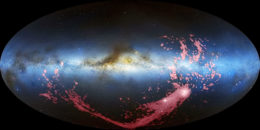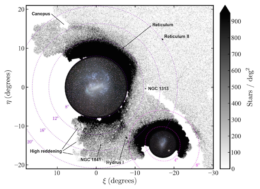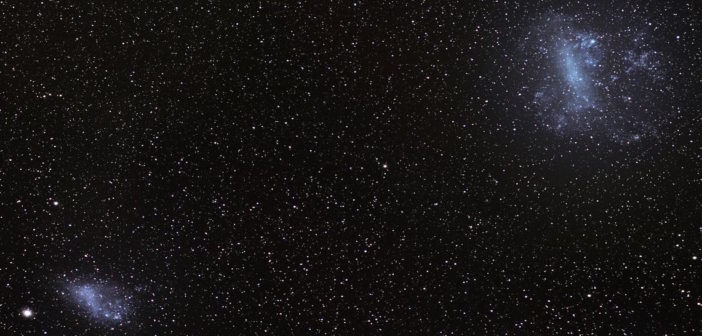The Magellanic Clouds — two nearby dwarf galaxies easily visible to the naked eye in the southern hemisphere — are key to understanding the dynamics and evolution of the Local Group of galaxies. Can an in-depth look at these galaxies’ outer regions help us make sense of their complicated interaction history?
A Closer Look at Our Galactic Neighbors

A combined optical and radio view of the Milky Way and the Magellanic Stream, shown in pink. [David L. Nidever, et al., NRAO/AUI/NSF and Mellinger, Leiden/Argentine/Bonn Survey, Parkes Observatory, Westerbork Observatory, and Arecibo Observatory]
It was originally thought that the Magellanic Stream was the result of tidal interactions during close encounters with the Milky Way, but precise proper motion surveys revealed that the LMC and SMC are either passing near the Milky Way for the first time or are in a long (~4-billion-year) orbit around our galaxy — so the Magellanic Stream must result from interactions between the two galaxies themselves.
How long have the LMC and SMC been interacting, and how have these interactions shaped the two galaxies? A key to understanding the history of these dwarf galaxies is mapping the weakly gravitationally bound stars at their far edges that may be pulled into tidal streams or bulges as each galaxy is distorted by the presence of the other.

A map of the density of ancient stars surrounding the Magellanic Clouds reveals extended structures to the north and south of the LMC, while the western regions of the galaxy (to the right) are truncated. Click to enlarge. [Adapted from Mackey et al. 2018]
Mapping the Edges of Galaxies
Dougal Mackey (Australian National University) and collaborators used visible and near-infrared images taken by the Dark Energy Camera (DECam) — the workhorse instrument of the Dark Energy Survey — to map the faint outskirts of the LMC and SMC.
Though the purpose of the Dark Energy Survey is to better understand the nature of dark energy through observations of supernovae, weak gravitational lenses, and galaxy clusters, its sensitive imaging system and wide field of view (2.2 degrees in diameter) make it well-suited to exploring the faint fringes of nearby galaxies.
The DECam images of the Magellanic Clouds probed to a surface brightness of 32 magnitudes per square arcsecond, allowing Mackey and collaborators to investigate how different stellar populations are distributed in the outer regions of these galaxies.

Stellar density maps for young (<1 Gyr) and intermediate-age (1.5–4 Gyr) populations. The young stars trace a bridge between the galaxies, while the intermediate-age stars are offset from the ancient stars in the direction of the LMC. Click to enlarge. [Adapted from Mackey et al. 2018]
Structures Revealed in Faint Starlight
Mapping the density of stars revealed distinct stellar substructures on the outskirts of the LMC and SMC. While previous studies discovered isolated substructures on the outer limits of the LMC, the panoramic view from this study highlights the interconnected nature of the structures.
One important finding is that the intermediate-age (1.5–4 Gyr) stellar population of the SMC is distinctly offset from the ancient (~11 Gyr) stellar population. This result suggests that the Magellanic Clouds may have been gravitationally linked as far back as several billion years — hinting that these galaxies are on their first trip past the Milky Way. Future simulation work may provide a more cohesive picture of the LMC–SMC interaction, helping us better understand how our near neighbors have evolved.
Citation
Dougal Mackey et al 2018 ApJL 858 L21. doi:10.3847/2041-8213/aac175

5 Comments
Pingback: Disentangling the History of the Magellanic Clouds
Pingback: Desenredando la historia de las Nubes de Magallanes – Observatori Astronòmic
Pingback: Desenredando la historia de las Nubes de Magallanes « SEDA / LIADA - RedLIADA - Cursos LIADA - Cielo del Mes - Fenómenos Astronómicos - RELEA
Pingback: Desenredando la historia de las Nubes de Magallanes « Sección de Astrofísica de la LIADA
Pingback: Die drei Magellanschen Wolken? – Alpha Cephei